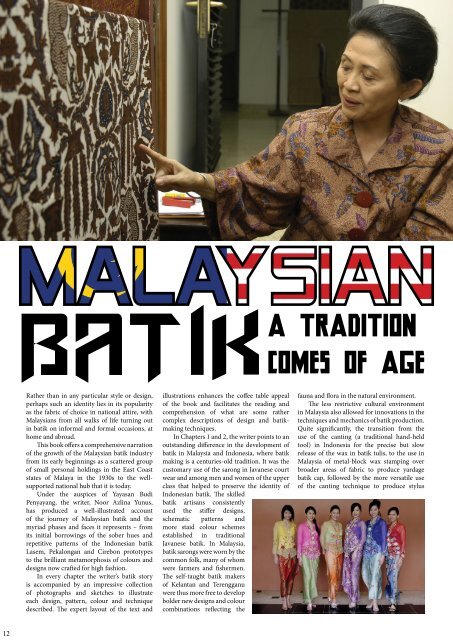Create successful ePaper yourself
Turn your PDF publications into a flip-book with our unique Google optimized e-Paper software.
A TRADITION<br />
BATIKCOMES OF AGE<br />
Rather than in any particular style or design,<br />
perhaps such an identity lies in its popularity<br />
as the fabric of choice in national attire, with<br />
Malaysians from all walks of life turning out<br />
in batik on informal and formal occasions, at<br />
home and abroad.<br />
This book offers a comprehensive narration<br />
of the growth of the Malaysian batik industry<br />
from its early beginnings as a scattered group<br />
of small personal holdings in the East Coast<br />
states of Malaya in the 1930s to the wellsupported<br />
national hub that it is today.<br />
Under the auspices of Yayasan Budi<br />
Penyayang, the writer, Noor Azlina Yunus,<br />
has produced a well-illustrated account<br />
of the journey of Malaysian batik and the<br />
myriad phases and faces it represents – from<br />
its initial borrowings of the sober hues and<br />
repetitive patterns of the Indonesian batik<br />
Lasem, Pekalongan and Cirebon prototypes<br />
to the brilliant metamorphosis of colours and<br />
designs now crafted for high fashion.<br />
In every chapter the writer’s batik story<br />
is accompanied by an impressive collection<br />
of photographs and sketches to illustrate<br />
each design, pattern, colour and technique<br />
described. The expert layout of the text and<br />
illustrations enhances the coffee table appeal<br />
of the book and facilitates the reading and<br />
comprehension of what are some rather<br />
complex descriptions of design and batikmaking<br />
techniques.<br />
In Chapters 1 and 2, the writer points to an<br />
outstanding difference in the development of<br />
batik in Malaysia and Indonesia, where batik<br />
making is a centuries-old tradition. It was the<br />
customary use of the sarong in Javanese court<br />
wear and among men and women of the upper<br />
class that helped to preserve the identity of<br />
Indonesian batik. The skilled<br />
batik artisans consistently<br />
used the stiffer designs,<br />
schematic patterns and<br />
more staid colour schemes<br />
established in traditional<br />
Javanese batik. In Malaysia,<br />
batik sarongs were worn by the<br />
common folk, many of whom<br />
were farmers and fishermen.<br />
The self-taught batik makers<br />
of Kelantan and Terengganu<br />
were thus more free to develop<br />
bolder new designs and colour<br />
combinations reflecting the<br />
fauna and flora in the natural environment.<br />
The less restrictive cultural environment<br />
in Malaysia also allowed for innovations in the<br />
techniques and mechanics of batik production.<br />
Quite significantly, the transition from the<br />
use of the canting (a traditional hand-held<br />
tool) in Indonesia for the precise but slow<br />
release of the wax in batik tulis, to the use in<br />
Malaysia of metal-block wax stamping over<br />
broader areas of fabric to produce yardage<br />
batik cap, followed by the more versatile use<br />
of the canting technique to produce stylus<br />
12



